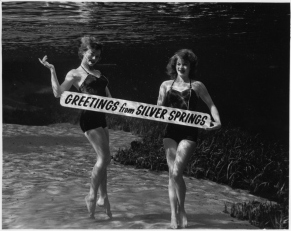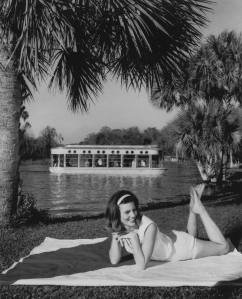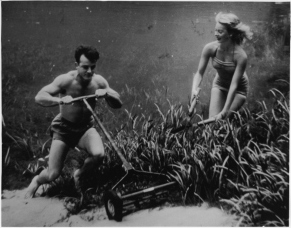Gary Monroe Considers the Fate of Silver Springs
Florida’s vanishing springs, an ongoing concern for the state, have been a hot topic in the news again recently. In this guest post, beloved UPF author and Florida native, Gary Monroe, responds to the state’s intention to reclaim Silver Springs from Festival Fun Parks and attempt to prevent further environmental degradation of the natural wonder.
The Fate of Silver Springs, Florida’s Paradise on Earth

©2008 Bruce Mozert
In the nineteenth century, steamers often brought lumber, supplies and intrepid travelers down Florida’s St. Johns River to the center of the state. More adventurous wayfarers might switch to a smaller riverboat in Palatka to traverse the crooked and narrow Ocklawaha River. From there, they could venture up the Silver River to its headwaters, Silver Springs, tucked in the state’s interior.
Silver Springs was the Disney World of its day—Florida’s premier tourist attraction. Its crystal clear water was so transparent that Victorians were astonished, thinking that the abundant fish were suspended in air. An underwater wind seemed to blow the eelgrass. Here unexplainable beauty bordered on the mystical; travelers peered in through glass-bottom boats.
As Henry Flagler’s Florida East Coast Railway unfurled down the state to Key West, modern tourism followed. Silver Springs realized its second life after WWII. Tourists, now car-driven, arrived in mass. A new management publicized the place aggressively, reaching a crescendo as Bruce Mozert became Silver Springs’ image-maker par excellence. Mr. Mozert orchestrated photographs for mass-consumption, luring tourists. He dove into the waters with his camera to showcase Silver Springs, offering aspects of everyday life recreated beneath the surface.
The photographs are Florida vaudeville, shtick for the camera and mass consumption. Cleverly staged underwater, a 1950s secretary sits on the boss’s lap. A flirtatious blonde beckons for attention while sitting on a giant fishing hook. A woman cooks on an old stove while putting a wooden spoon to her mouth to sample the dish. Another woman wears a witch’s hat as she rides a broomstick, seeming to fly as she is suspended in the water. The water had to be invisible to make the illusions seem real—the key ingredient to Silver Springs’ success was the 99% pure water that gushed from the vents.
Drawn to the springs by Mozert’s photographs, guests could take a Jungle Cruise through the untamed wilds surrounding the Silver River, where the boat captain fed monkeys brought in from Southeast Asia. The glass-bottom boats would stop at the Shrine of the Water Gods. Visitors could go to the Prince of Peace memorial where the Life of Jesus Christ was depicted in dioramas throughout seven small chapels; sculptures were seen in muted lighting as soft music played in the background. They could visit the Deer Ranch or Santa’s Land or an elaborate greenhouse filled with exotic flowers.

©2008 Bruce Mozert
When folks boarded a boat, Bruce Mozert or one of his staffers would take a group picture of the excited adventurers about to depart. When guests returned at least 45 minutes later, they would find a 5”x7” glossy photograph in a themed folder available to purchase for $1.00–a good sum in the 1950s, when some 50,000 were sold yearly. Silver Springs sold more key chains, decorative spoons, and assorted tchotchkes than competitors like Cypress Gardens, Weeki Wachee, Marineland, Seaquarium, Alligator Farm, Parrot Jungle and Monkey Jungle.
The park was a moneymaker in its heyday, but as the attraction grew in popularity so did the myriad of sideshows and concessions, making it increasingly crass and kitschy. Big petting zoos and amusement park rides cheapened this wonderful place. As development increased in the area, runoff carried chemicals into the aquifer; pollutants killed off the life in the springs; its waters were no longer clear. Water slides and stage shows starring aging entertainers were added in an attempt to replace the natural splendor that had drawn visitors for a century. Attendance waned; these new additions couldn’t sustain the park with Disney World nearby and a modern Interstate system that evaded Silver Springs.
Bruce Mozert recently lamented, “When I started working at Silver Springs…[b]asically the water was so clear you could see through the water from the swimming area across to the opposite shoreline which was probably over 250 feet. Today there is a haze to it. The beach is gone.”

©2008 Bruce Mozert
This year, Silver Springs will become a state park. Its trademark glass bottom boats will still tour the springs, and there will continue to be concerts, food services, and gift shops; there will also be canoeing, kayaking and swimming. Sally Lieb, manager of Silver River State Park, explains, “The Department of Environmental Protection’s Division of Recreation and Parks will pursue our mission to provide resource-based recreation while preserving and restoring the resource as much as we can.”
It looks like everyone wins, and can learn things along the way.
Gary Monroe is the author of Silver Springs: The Underwater Photographs of Bruce Mozert. His other books include The Highwaymen: Florida’s African-American Landscape Painters and Extraordinary Interpretation: Florida’s Self-taught Artists, as well as other books and articles about nontraditional art. Visit his web site, through which he may be contacted, at www.garymonroe.net. |
|